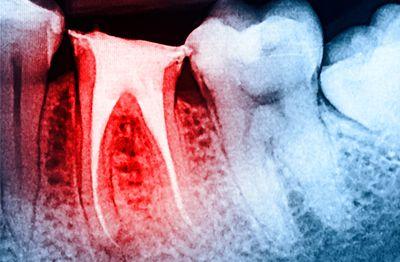
Root canal treatment/therapy may sound scary, but it’s no more uncomfortable than any other dental treatment. And if you act quickly, prompt treatment gives rapid relief to your pain.
What is endodontic (root canal) treatment?
Endodontics is the treatment or study of the ‘dental pulp’, the soft tissue inside your tooth. This tissue contains all your blood vessels and nerves and extends right through the tooth to its root.
Over time, through decay, disease or injury, your root canal may become inflamed or infected, which is when we may recommend root canal therapy.
 You’re in safe hands
You’re in safe hands
Mills Road Dental is a QIP Approved Dental Clinic with highly experienced Australia-trained dentists Dr Aran Moorthy and Dr Anthony Poli.
Symptoms of pulp infection or inflammation
Classic symptoms and signs include:
- Dull, throbbing toothache
- Extreme sensitivity to hot or cold which lingers for some time
- Tenderness when chewing
- A bad taste or smell in your mouth
If left untreated, this infection will worsen, with the bacteria breaking down more of the tooth. If there is too much damage, your dentist will have to remove the tooth.
Root canal therapy involves removing the dental pulp tissue inside the tooth, leaving the hard exterior shell, allowing you to keep your remaining tooth. The sooner we can get to your tooth to treat the condition, the better the chances are of succeeding. If we delay treatment, the nerve may become increasingly irritated or inflamed, making root canal therapy far more painful.
Your endodontic treatment
Root canal usually involves two treatments but it can be up to four. However, before your procedure, you’ll need to have discussed all options with your dentist and have decided that root canal therapy is your preferred course of action.
Your first visit
Sometimes on your first visit, the dentist will simply remove the nerve so you can become pain-free. However, at other times, the dentist will start to clean and examine the area.
Using endodontic files (which are a bit like bottle brushes), the diseased tooth and pulp debris are thoroughly cleaned from the middle of the tooth and its roots. Your dentist will assess your nerves and teeth by closely studying x-ray images before and during the procedure.
Along with physically cleaning the area, the roots are flushed with anti-bacterial solution to remove any bacteria and floating debris. Afterwards, the root is dressed with an antibacterial dressing. A temporary filling is placed over the top, preventing the tooth from reinfection.
Your second visit
On your second visit, the tooth is reopened and assessed to ensure that no bacteria has remained in the area. Then it is flushed with more anti-bacterial solution. The roots are filled with cold or warm rubber points and bonded to the side of the root canal with sealant. Finally, a restoration or crown is placed over the tooth to protect the tooth from being broken and allowing bacteria to re-enter and reinfect the tooth.
Occasionally, a third or fourth appointment might be required if the infection does not abate.
The aim of root canal therapy is to remove the infected pulp of the tooth, so you avoid having it extracted. After successful root canal therapy, you’ll be left with a natural, functioning tooth – with a natural-looking appearance – instead of a gaping hole in your smile. And, you’ll avoid having to spend thousands on expensive restorative dental work in the future.
To make sure reinfection never recurs, you must adhere to regular x-rays and reviews of your tooth. Your dentist will recommend the frequency of your reviews.
All surgical procedures carry risks. Before proceeding, you should seek a second opinion from an appropriately qualified health practitioner.

 You’re in safe hands
You’re in safe hands